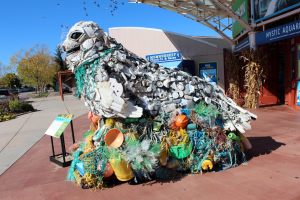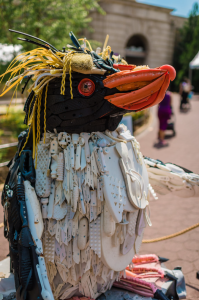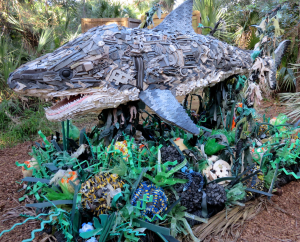Isabell Gutowski
Isabell Gutowski
PREFACE: My name is Isabell Gutowski and my portfolio is titled Angela Haseltine Pozzi – Saving Our Sea-Life. The type of license I will be using is CC BY-NC.
INTRODUCTION
Angela Haseltine Pozzi is an American artist who uses ocean trash to create sculptures of sea creatures. She was born in Oregon in 1957 to a very artistic family. She spent most of her time growing up by the coast. As Pozzi grew older, she realized the effect plastic pollution was having on the sea life near her home. Fish were rolling up on the shore trapped in nets, and birds were choking on garbage and plastic. Pozzi felt that this issue needed to be addressed, so she created the Washed Ashore Project. Pozzi collects trash from the Oregon coast and turns it into large sculptures of marine life for this project. Each animal created is made out of the trash that harms that species. Over 40,000 pounds of garbage and almost 70 sculptures have been created since the project started. Pozzi’s main goal is to educate the public about how our trash harms sea-life and hopefully create some change in how we dispose of our garbage. I will be analyzing three of her sculptures, a seal, a penguin, and a shark, and explain the meaning behind them and what they helped accomplish for the Washed Ashore Project.
THEMES
There are two major environmental themes that are portrayed in Angela Haseltine Pozzi’s work. The first is plastic pollution awareness and the second is portraying our sea-life as beautiful. By making each sculpture out of plastic/garbage found in the ocean and by aesthetically arranging each piece, Pozzi accomplishes each of these themes. People will be inspired to help the Washed Ashore cause when they notice how plastic is harming our magnificent sea creatures.



ANALYSIS
The Washed Ashore project was founded in 2010 by Angela Haseltine Pozzi. It is a nonprofit organization that uses sculptures to educate the public about plastic pollution and environmental conservation. Pozzi gives human names to each of her sculptures to personify them.
The first image is of a seal named Lidia created by Pozzi in 2013 as part of this project. Lidia the seal sits on top of buoys, netting, and ropes. Pozzi chose to incorporate these pieces into the sculpture because nets, ropes, and buoys are what harm seals in the ocean. Seals get these tangled around their necks or bodies which often leads to death if not found and treated. This can also be seen in the image with Lidia the seal having a green net wrapped around her neck. By adding these specific details to the sculpture, Pozzi can educate the public about how ropes and netting pollution effects seals and hopefully raise additional awareness on the topic.
The second image is of a rockhopper penguin named Zorabelle. Pozzi created this sculpture in 2015. Zorabelle is created entirely of hard plastics for the body with some softer plastics and zip ties for the hair. Pozzi chose to incorporate these pieces into the sculpture because plastic pollution is harming penguins. Penguins mistake plastic for food. This can cause major damage to the bird because some plastic is indigestible. This plastic will then sit in the penguin’s stomach and prevent it from digesting actual food. Plastic also contains a lot of toxins which can cause health problems for penguins. By adding these specific details to the sculpture, Pozzi can educate the public about how plastic effects penguins and hopefully raise additional awareness on the topic.
The third image is of a shark named Chompers. Pozzi created this sculpture in 2018. Chompers is made out of hard plastics with seaweed below also made out of hard plastics. Plastic is very harmful to sharks and that is why Possi chose to incorporate it into this sculpture. When sharks eat plastic, it damages their stomach lines, blocks their digestive tracks, and lessens their need to feed because they think they think they are full. This ultimately causes sharks to go hungry. Pozzi also chose to make the seaweed in this sculpture out of plastic due to the fact that there is over 14 million tons of it on the ocean floor. This is just another way Pozzi made her sculpture more accurate to the problems going on from plastic pollution. By adding these specific details to the sculpture, Pozzi can educate the public about how plastic effects sharks and the ocean floor and hopefully raise additional awareness on the topic.
Pozzi’s hope is that people will come together to help clear our oceans and save sea creatures. I hope that in the future plastic pollution will be on the decline and when people see Pozzi’s sculptures they will just see them as inspiration to not go back to the past rather than seeing them as a problem that needs to be fixed.
APPLICATION
Plastic pollution is a very prevalent issue in the world today that needs to be stopped. Our oceans and sea life are suffering due to the carelessness of humans in how we dispose of our garbage. Blue oceans are now turning grey with trash, and the beautiful sea creatures that are living in them are slowly becoming extinct. This generation is producing disposable plastic products at a rate at which is too overwhelming to deal with. Most people today will never experience a beach without garbage, and soon, new generations of people won’t even be aware of some of the magnificent creatures that roam our oceans. This makes me feel incredibly sad and guilty that we are destroying the lives and habitats of many creatures that roamed the earth before we did. I feel as though Angela Haseltine Pozzi should be considered a hero for her efforts to raise awareness on this topic. Her artwork is crucial for educating society on the impact they have on the environment. I think it was genius of Pozzi to create each animal sculpture with the trash that harms that species. This way her elegant sculptures can function as educational pieces to the public. I for one became more enlightened on this issue by just analyzing three pieces of Pozzi’s work. The intricate details in each sculpture helped me understand which types of plastic harm sea-life and which types I should be extra cautious in disposing of. Although the Washed Ashore project is helping to raise awareness of plastic pollution, there aren’t any signs of it stopping any time soon. Pozzi’s sculptures will continue to be an important contribution to pollution efforts as they serve as a reminder of how we are harming our planet.
SOURCES:
Guy, A. (2021). The Top 5 Threats to Penguins – And What You Can Do to Help. Oceana. https://oceana.org/blog/top-5-threats-penguins-and-what-you-can-do-help/
Lidia the Seal. (2023, May 11). Smithsonian Ocean. https://ocean.si.edu/human-connections/books-film-arts/lidia-seal
Márquez, M. C. (2018, October 21). The Low Down On Plastic Pollution And How It Affects Sharks. Forbes. https://www.forbes.com/sites/melissacristinamarquez/2018/10/20/the-low-down-on-plastic-pollution-and-how-it-affects-sharks/?sh=4e7e396422a9
Prisco, J. (2016, September 2). Enchanting marine sculptures made from washed ashore plastic. CNN. https://www.cnn.com/style/article/washed-ashore-plastic/index.html
This is how much plastic scientists now think is at the bottom of the ocean. (2020, November 2). World Economic Forum. https://www.weforum.org/agenda/2020/11/marine-microplastics-pollution-ocean-australia/
Wikipedia contributors. (2022). Angela Haseltine Pozzi. Wikipedia. https://en.wikipedia.org/wiki/Angela_Haseltine_Pozzi#:~:text=Angela%20Haseltine%20Pozzi%20%28born%201957%29%20is%20an%20American,a%20polar%20bear%2C%20puffin%2C%20jellyfish%2C%20and%20an%20octopus.
Media Attributions
- Lidia the Seal is licensed under a CC BY-NC-ND (Attribution NonCommercial NoDerivatives) license
- trash penguin is licensed under a CC BY-NC-ND (Attribution NonCommercial NoDerivatives) license
- trash shark is licensed under a CC BY-NC-ND (Attribution NonCommercial NoDerivatives) license

